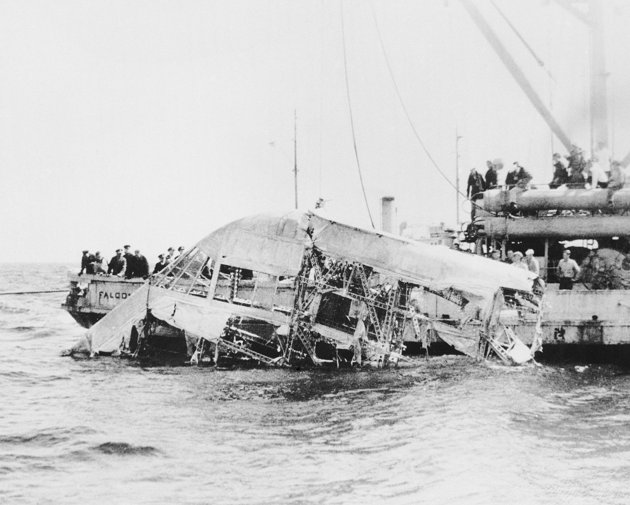On This Day: World’s biggest helium airship plunges into sea
APRIL 4, 1933: The world’s biggest helium airship plunged into the sea and killed 73 people, after being damaged in thunderstorm on this day in 1933.
The USS Akron, whose sister ship would also suffer a similar fate two years later, crashed into the Atlantic off the New Jersey coast.
The 785ft-long flying aircraft carrier was battered by heavy winds and spiralled ever downwards despite captain Commander Frank McCord’s efforts to drop ballast.
As she touched the water, the tailfin of the Akron, a floating aircraft carrier which could bear up to five biplanes, tore off and the rest of the airship began to break up.
Only three U.S. Navy sailors, out of a crew of 76, survived the ordeal after most of the men – none of whom had lifejackets – either drowned or died of exposure.
A British Pathé newsreel shows aerial footage of the wreckage and the Coast Guard cutter Tucker taking victims to shore.
It was the fourth accident to befall the Akron, which was named after the Ohio city where it was built.
Prior to this incident, the worst had taken place in May 1932 when two men holding the anchor lines were dragged into the air and killed after plunging to the ground.
Among the survivors of its tragic ending was Lieutenant Commander Herbert Wiley, would go on to captain the Akron’s ill-fated sister ship, USS Macon.
The Macon sank on the opposite side of the continent off the coast of California, less than two years later in February 1935 after the tailfin was torn off in a storm.
The crew rushed to escape and remarkably only two men died – making it one of the few airship tragedies without massive loss of life.
One was killed after he jumped ship while still too high above the ocean and another drowned while swimming back to the wreckage to try to fetch some of his belongings.
A third man also nearly drowned – but was rescued by Commander Wiley, who swam to his aid and was later decorated for the deed.
Along with the warm Pacific water, the men able to survive thanks to the newly issued life jackets and inflatable rafts.
The two major disasters – each within two years of the vessels being commissioned – meant that they were the last rigid airships built for the U.S. Navy.
Germany, which had pioneered this travel revolution, continued to fly civil airships, however during an era when fix-wing aircrafts were still in their infancy.
Graf Zeppelin completed the first passenger flight across the Atlantic in 1928 – earning the crew a ticker-tape parade down New York’s Canyon of Heroes.
But increasing safety fears, combined with the Great Depression damaging the global luxury travel market, hit the airship industry hard.
However, it was the fate of the hydrogen-filled Hindenburg, the world’s largest airship of any kind, which irrevocably shattered public faith in hydrogen-filled airships.
A total of 35 people died after the flammable gas exploded just as the Hindenburg landed at Lakehurst, New Jersey following a flight from Berlin.
In the aftermath, German operators tried to substitute cheap hydrogen with expensive helium, which was inflammable. But the U.S. controlled global production of the gas and, despite now only having a few limited military blimps, refused to grant an export licence. Also, the design of fixed-wing aeroplanes had become so technologically advanced by then that they had effectively become obsolete.
The U.S. and other naval powers concentrated on building ships that would serve as aircraft carriers.







